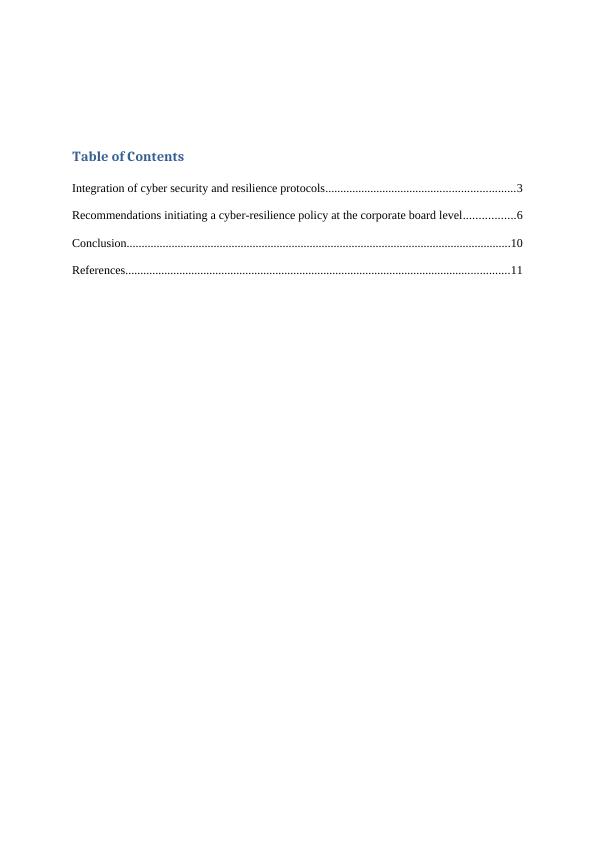Integration of Cyber Security and Resilience Protocols
Added on 2023-06-07
12 Pages3291 Words393 Views
Assessment Task 3
Case Study
Case Study

Table of Contents
Integration of cyber security and resilience protocols...............................................................3
Recommendations initiating a cyber-resilience policy at the corporate board level.................6
Conclusion................................................................................................................................10
References................................................................................................................................11
Integration of cyber security and resilience protocols...............................................................3
Recommendations initiating a cyber-resilience policy at the corporate board level.................6
Conclusion................................................................................................................................10
References................................................................................................................................11

Integration of cyber security and resilience protocols
Countering cyber risk is one of the major concerns for leaders across different industries. The
vast technological advances in the area of networked technology however present several
opportunities that can be used by organizations as an advantage for countering the cyber risks
in their early stages. Cyber security is about protection of the interconnected systems that
includes data, hardware and software from the cyber attacks. For example: the implantable
cardiovascular defibrillators in the healthcare sector are susceptible to short-range wireless
attacks. For this purpose, short range radio can be used for managing the capabilities of the
device (Cavelty, 2014).
With the advancements in networked technology, the power of cyber attackers has also
significantly increased and with this, the concept of cyber resilience came into existence.
Cyber resilience is a broader approach that includes both the business continuity management
and the cyber security. Cyber resilience not only aims at defending the cyber attacks but it
also helps in ensuring the survival of an organization followed by an attack. This indicates
that resilience of an organization towards the cyber attacks is one of the critical survival traits
in the future (Bagheri & Ridley, 2017). Cyber resilience is a concept that is constantly
evolving and rapidly gaining recognition. This concept brings together the areas of business
continuity, organizational resilience and the information security. In order to be resilient to
the cyber attack, some of the essential elements include critical infrastructure, business
processes and IT systems. The adverse cyber attacks can be referred to as the events, which
can negatively impact the integrity, availability or the confidentiality of the information
system and the IT systems. The overall objective of cyber resilience is to maintain
organization’s ability to continuously deliver the outcomes even when the regular delivery
mechanisms of the organization fail such crisis after the breach (Wilding, 2016).
Countering cyber risk is one of the major concerns for leaders across different industries. The
vast technological advances in the area of networked technology however present several
opportunities that can be used by organizations as an advantage for countering the cyber risks
in their early stages. Cyber security is about protection of the interconnected systems that
includes data, hardware and software from the cyber attacks. For example: the implantable
cardiovascular defibrillators in the healthcare sector are susceptible to short-range wireless
attacks. For this purpose, short range radio can be used for managing the capabilities of the
device (Cavelty, 2014).
With the advancements in networked technology, the power of cyber attackers has also
significantly increased and with this, the concept of cyber resilience came into existence.
Cyber resilience is a broader approach that includes both the business continuity management
and the cyber security. Cyber resilience not only aims at defending the cyber attacks but it
also helps in ensuring the survival of an organization followed by an attack. This indicates
that resilience of an organization towards the cyber attacks is one of the critical survival traits
in the future (Bagheri & Ridley, 2017). Cyber resilience is a concept that is constantly
evolving and rapidly gaining recognition. This concept brings together the areas of business
continuity, organizational resilience and the information security. In order to be resilient to
the cyber attack, some of the essential elements include critical infrastructure, business
processes and IT systems. The adverse cyber attacks can be referred to as the events, which
can negatively impact the integrity, availability or the confidentiality of the information
system and the IT systems. The overall objective of cyber resilience is to maintain
organization’s ability to continuously deliver the outcomes even when the regular delivery
mechanisms of the organization fail such crisis after the breach (Wilding, 2016).

There are some major principles associated with cyber resilience in an organization. One of
the ten principles given in the report of the World Economic Forum is the principle
associated with the integration of the cyber resilience. According to this principle, the board
of an organization ensures the integration of the cyber resilience and the risk assessment
related to the cyber risk with the overall strategy of the business, resource allocation and the
budgeting (World Economic Forum, 2017).
This report will focus on how the organization can integrate its cyber security and resilience
protocols to ensure continued corporate survival and improved business performance. In
addition, this report will also present the examples of best practice and a clear set of
recommendations for organization on initiating a cyber resilience policy at the corporate
board level. The two major ideas in the context of integrating the cyber security and
resilience protocols focus on leadership and a mindset that goes beyond cyber security so as
to build an effective corporate strategy that can be incorporated in the overall strategic
thinking. The report will focus on the tools that are used at the corporate board level for
integrating the cyber security and resilience protocols. This will help the organization in
growing and innovating sustainably (World Economic Forum, 2017).
The integration of cyber strategy into the organizational strategy or the business strategy is a
challenge. The board of the organization should ensure the integration of cyber resilience and
risk assessment in the strategy of the business, budgeting and the resource allocation of the
business (World Economic Forum, 2017). In this context, the board of the organization
should focus on evaluation of the cyber resilience and cyber risks with the help of risk
assessment. For this purpose, the board can use the Risk Benchmarking method. It is a
method with which different types of risks involved in the business are identified using a
benchmark such as NASDAQ (Peter, 2017). Some of the potential items that can be used by
the board for the risk benchmarking include the demographic factors, risk portfolio factors,
the ten principles given in the report of the World Economic Forum is the principle
associated with the integration of the cyber resilience. According to this principle, the board
of an organization ensures the integration of the cyber resilience and the risk assessment
related to the cyber risk with the overall strategy of the business, resource allocation and the
budgeting (World Economic Forum, 2017).
This report will focus on how the organization can integrate its cyber security and resilience
protocols to ensure continued corporate survival and improved business performance. In
addition, this report will also present the examples of best practice and a clear set of
recommendations for organization on initiating a cyber resilience policy at the corporate
board level. The two major ideas in the context of integrating the cyber security and
resilience protocols focus on leadership and a mindset that goes beyond cyber security so as
to build an effective corporate strategy that can be incorporated in the overall strategic
thinking. The report will focus on the tools that are used at the corporate board level for
integrating the cyber security and resilience protocols. This will help the organization in
growing and innovating sustainably (World Economic Forum, 2017).
The integration of cyber strategy into the organizational strategy or the business strategy is a
challenge. The board of the organization should ensure the integration of cyber resilience and
risk assessment in the strategy of the business, budgeting and the resource allocation of the
business (World Economic Forum, 2017). In this context, the board of the organization
should focus on evaluation of the cyber resilience and cyber risks with the help of risk
assessment. For this purpose, the board can use the Risk Benchmarking method. It is a
method with which different types of risks involved in the business are identified using a
benchmark such as NASDAQ (Peter, 2017). Some of the potential items that can be used by
the board for the risk benchmarking include the demographic factors, risk portfolio factors,

End of preview
Want to access all the pages? Upload your documents or become a member.
Related Documents
Corporate Governance & Ethics Case Study Report based on cyber resilience policy 2017lg...
|15
|3682
|194
Cyber Resilience: Principles, Toolkits, and Frameworks for Corporate Boardslg...
|12
|3245
|237
Countering cyber risk EXECUTIVE SUMMARY: Cyber Resilience Principles for Business Activitieslg...
|11
|3086
|363
Report On Cybersecurity Policy | ACC03043 Corporate Governancelg...
|15
|3207
|33
ACC03043 - Corporate Governance - Reportlg...
|11
|2929
|107
Cyber Security and Cyber Resilience: A Board of Directors' Guidelg...
|9
|2583
|350
